Two members of West Mead #1 attended the Crawford/Venango County Fire School on September 9-10, 2017. They submitted the following reports.
Mass Casualty Incident/Triage
I attended the Mass Casualty Incident/Triage course at the Crawford-Venango Counties Fire School on September 9th and 10th. Don Erbin, Jr., an EmergyCare paramedic and Fire Chief of the Kuhl Hose Company in Erie County, was the instructor.
In short, a Mass Casualty Incident (MCI) is an emergency situation in which the quantity of patients overwhelms the available emergency medical services resources. Some common examples of mass casualty incidents are bus accidents, passenger jet crashes, active assailant attacks, and bombings.
We were instructed that when a Mass Casualty Incident occurs, it is essential that the first arriving responder conduct a size-up of the scene, declare an MCI on the dispatch or operational radio frequency, request additional resources, establish command, and initiate Triage. Triage is the systematic sorting of patients into four primary groups so that the worst are treated and transported first. MCI patients are initially assigned to one of these color-coded groups: Minor – green (walking wounded), Delayed – yellow, Immediate – red, or Deceased – black. Responders attach triage tags and/or colored tape/ribbon to the patients to identify the severity of their injuries.
The purpose of Triage is to save as many lives as possible. In order to properly classify each patient in thirty seconds or less, we were taught the Simple Triage and Rapid Treatment (START) system. When utilizing the START system, responders evaluate patients’ Respirations, Perfusion (circulation), and Mental status (RPM). We were instructed to quickly control severe bleeding and to re-position the heads of non-breathing patients in order to open their airways in hopes that spontaneous respirations will resume. Once patients are triaged, they are then treated and transported in order of the severity of their injuries.
The instructor reviewed Leadership and the Incident Command System. He utilized videos and photographs of local and national mass casualty incidents to illustrate the various challenges faced by responders during these types of events. He then facilitated several table-top exercise scenarios of increasing severity and complexity to test our triage, treatment, and transport skills and knowledge.
Mass Casualty Incident/Triage was a very informative and thought-provoking course. The students were given multiple opportunities to practice their triage skills. Hopefully none of us will ever need to utilize them in a real MCI.
Don R. Bovard
Basement Fires and Flashover Recognition
You’re packed up and ready to go interior on a working basement fire. The lieutenant swings the back door open, and the doorway fills top to bottom with dense gray smoke. Dragging the charged 1 3/4″ hoseline, you scoot along the floor, searching in the dark for that doorway and basement stairs the homeowner said was just inside the kitchen to the left. There’s the basement door! It bangs open and you are hit with a blast of heat and smoke from the bowels of the building. What awaits you below? A five-gallon can of gasoline? A store of ammunition? A hoard of trash? Several propane tanks? A 55-gallon drum of nitro? Exactly why did you volunteer for this job?
This is why nineteen firefighters signed up for the Basement Fires and Flashover Recognition class at Crawford/Venango Counties Fire School. Fire Instructor Al Wickline of Allegheny County Fire Academy taught the class that prepared firefighters for the challenges and hazards of basement fires. Mr. Wickline was assisted by fire instructors Nelson Miller and Kurt Christofel, with several additional instructors during the live fire exercises.
Class instruction focused on the challenges firefighters encounter in basement fires, from hazardous storage to limited access. With different basement styles such as lookout, walkout, walkup, and window well egress, firefighters must assess the building and plan their tactics accordingly. Failure to size-up the building has contributed to line of duty deaths (LODD), such as the Bricelyn Street fire in Pittsburgh in 1995. Remodeling and additional partitions can add to the complexity and limit access to the basement. If an interior stairway is the primary means of egress, then protecting that stairway is essential.
Mr. Wickline also described flashover, the moment when the combustible contents of a container ignite almost simultaneously. The high-tech turnout gear will not protect firefighters in heat nearing 1000 degress. Turnout gear can protect firefighters for five seconds up to 1200 degrees, but face pieces of most breathing apparatus are only good to 350 or 400 degrees. Firefighters must be prepared to cool the room, attack the fire, or evacuate the area. The penciling technique of applying quick bursts of water to the ceiling was introduced as an option to buy firefighters more time. The idea was to cool the room just enough to reach the fire compartment or get out of danger.
Instructor Kurt Christofel used a fire box to demonstrate the flow path of a fire in a garden-style apartment that resulted in the death of Maryland Firefighter Mark Falkenhan in 2011. Ventilation must be coordinated with fire attack or the results can be deadly. A lower-story air inlet can turn a multi-story building into a blowtorch.
The hands-on portion of the class was conducted at Saegertown Volunteer Fire Department’s burn trailer. Teams of 3 or 4 practiced advancing a hoseline down a stairway, then following the hoseline down the stairs to attack a fire in the trailer. On Sunday the training included live fire, with teams advancing on a closed or blocked door, forcing the door, and applying water to the fire. The firefighters also observed roll-over, where flames begin to dance along the ceiling and the room moves toward flashover. Each firefighter practiced penciling to cool the super-heated gases.
Working with teams of firefighters from different departments was a good exercise in communication and team-building. The live-fire practice was also a good refresher on basics of hoseline management.
Thanks to the fire instructors for sharing their knowledge and expertise, and Saegertown Volunteer Fire Department for the use of their station and burn trailer.
Ryan Zook
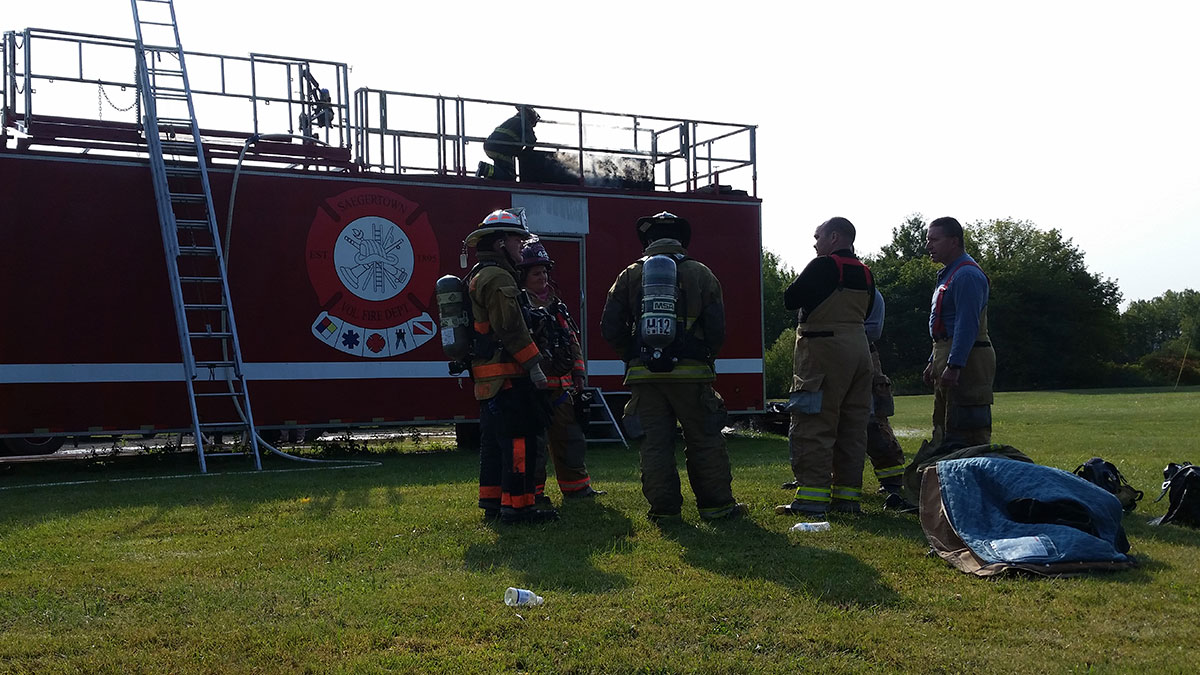
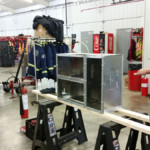
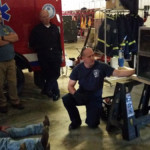
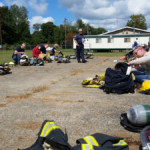
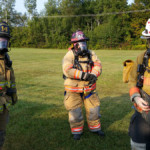
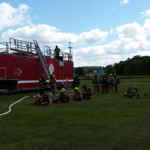
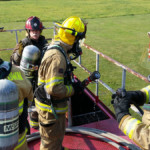
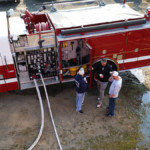
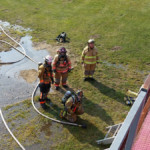
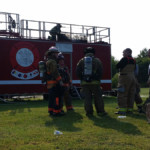
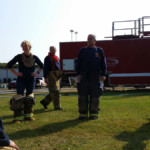
Leave A Comment